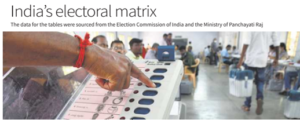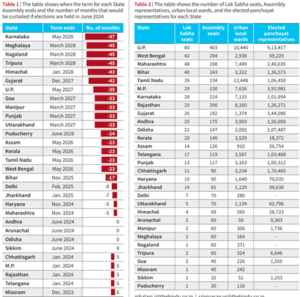Why simultaneous elections would militate against federalism.
The idea of simultaneous elections is untenable if its impact on existing Assemblies and the threetier system is considered.
Relevance
- GS Paper 2 Constitution of India —historical underpinnings, evolution, features, amendments, significant provisions and basic structure.
- Separation of powers between various organs dispute redressal mechanisms and institutions.
- Tags: #onenationonelection #constitution #federalism #currentaffairs #upsc.
Why in the News?
The government forms a committee to explore the possibility of One Nation, One Election.
Introduction
The concept of simultaneous elections has gained prominence in recent years, with the Union government forming a committee, led by former President Ramnath Kovind, to explore the possibility of conducting simultaneous elections at various levels of governance, including the Lok Sabha, Legislative Assemblies, municipalities, and panchayats.
This idea, which is part of the Bharatiya Janata Party’s manifesto, raises significant concerns, particularly when considering its impact on existing legislative bodies and the three-tier governance system.
Shortened Terms for Legislative Assemblies
- The next Lok Sabha election is scheduled before June 16, 2024. If simultaneous elections become a reality, it would result in the curtailment of the terms of all Legislative Assemblies except those in Andhra Pradesh, Arunachal Pradesh, Odisha, and Sikkim.
- These four states have synchronized their election cycles with the Lok Sabha over time. However, holding simultaneous elections in 2029 would require a similar exercise of either shortening or extending Assembly terms.
Cost Savings vs. Economic Impact
- The government has presented simultaneous elections as a cost-saving measure. A 2018 report by the Law Commission argued that election expenses for Lok Sabha and Assembly elections in any state are similar and that conducting them together would halve the costs.
- However, these reports often overlook the broader economic consequences of elections on sectors such as transportation, printing, media, and infrastructure.
- Treating election expenditure as “wasteful” fails to account for the multiplier effect and the impact on local economies.
Impact on Governance Tiers
- Many reports also fail to consider the implications of simultaneous elections on India’s multi-tiered legislative and governance system.
- Table 2 provides an overview of the number of Lok Sabha seats, Assembly representatives, urban local wards, and elected panchayat representatives for each state.
- India collectively elects 543 Lok Sabha representatives, over 4,100 Assembly legislators, representatives to 89,194 urban wards, and nearly 31.89 lakh elected panchayat representatives across three tiers of the Panchayat system, which includes village panchayats, panchayat unions, and district panchayats. Each tier serves unique roles and responsibilities, reflecting the diverse needs of the voters.
- For example, a voter concerned about local garbage management would elect a candidate best suited to address the issue in the local ward. In contrast, MPs and MLAs represent larger constituencies and focus on enacting laws related to the Union government and the state, respectively.
Federalism Concerns
- Aside from prematurely shortening Assembly terms, conducting simultaneous elections could lead to the consolidation of various issues across these three governance tiers under a single electoral mandate.
- This outcome could undermine federalism and the fundamental structure of three-tier governance in India. It is imperative for the committee to thoroughly assess the federal aspects of Indian democracy before pursuing simultaneous elections.
- ONOE seems to conflict with the federal structure, contradicting the idea of India as a Union of States (Article 1).
- Altering this balance might affect the autonomy and authority of state governments.
While the idea of simultaneous elections may have some merits, it must be critically evaluated in the context of its impact on legislative terms, economic considerations, and the integrity of India’s multi-tiered governance system. Balancing the need for cost-efficiency with the preservation of federalism and the distinct roles of each governance tier is essential for ensuring a functioning and effective democratic framework.
| ONOE Plan Overview
· The ONOE plan, or “One Nation, One Election” plan, aims to synchronize the timing of Lok Sabha and State Assembly elections across all states in India to reduce the frequency of election cycles nationwide. · Historical Context: Initially, after the enforcement of the Constitution in 1950, Lok Sabha and State Assembly elections were held simultaneously in 1951-1952 and for the next three Lok Sabha elections until 1967, streamlining the electoral process. · Disruption: The cycle was disrupted in 1959 when the Central government invoked Article 356, leading to the dismissal of the Kerala government. After 1960, defections and counter-defections among political parties resulted in the dissolution of several State Legislative Assemblies, leading to separate election cycles for Lok Sabha and State Assemblies. · Current Scenario: Currently, only specific states like Arunachal Pradesh, Sikkim, Andhra Pradesh, and Odisha conduct their assembly polls concurrently with the Lok Sabha elections. |
Sources: The Hindu
Mains Question
“Discuss the potential advantages and drawbacks of conducting simultaneous elections at the national, state, and local levels in India. How might this impact the federal structure of governance?” 250words.





